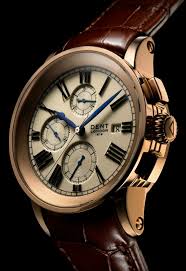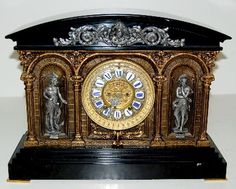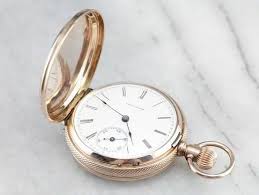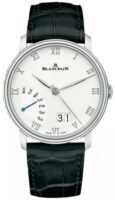








The history of Dent & Co. spans three centuries of precision watch and clock making in Great Britain. Established in 1814 by Edward J. Dent, the company embraced the Victorian fervour for technological innovation and created precision chronometers to navigate the Royal Navy and guide some of the most intrepid explorers on their voyages. The British Empire was in full expansion and its maritime tradition had produced some remarkable technological breakthroughs from the late 18th century; John Harrison’s triumphant mechanical solution in 1764 to locate a ship’s position at sea won the coveted Board of Longitudes prize money and further consolidated Britain as the horological force in the world. Propelling the impetus of Britain’s primacy, Dent proved a key player in Victorian horological history manufacturing the Standard Clock at the Royal Observatory, Greenwich which was to keep “Greenwich Mean Time” the time to which all others in the Empire were referred (better known today as G.M.T.) and continued to do so until replaced by an electronic clock in 1946. Dent also made probably the most famous clock in the world – the Great Clock for the Houses of Parliament, familiarly known as Big Ben.
Chronometers
Edward John Dent (1790-1853) discovered his passion for clock making from his cousin Richard Rippon and from 1814 onwards established an outstanding reputation as a builder of accurate chronometers; vital timepieces for Britain’s maritime conquests, trade and Colonial expansion. His inventive talents were soon recognized and a chronometer he had submitted to the trials was conferred the First Premium Award in the 1829 Greenwich Trials.
Dent’s reputation soared and their chronometers accompanied some of the century’s most influential and colourful explorers. Dent chronometer no. 633 was taken aboard the H.M.S. Beagle in 1831 to accompany Charles Darwin on the voyage that lead to his revolutionary publication “The Origin of the Species” – his groundbreaking theory of evolution. Two decades later, David Livingstone purchased Dent chronometer no. 1800 for his African explorations and in 1890, the explorer H.M. Stanley was moved to write to Dent that “the Chronometers supplied by you, and which were taken across Africa in my last Expedition, proved a very great service to me and were in every way thoroughly satisfactory and reliable”.
Standard Clocks
Dent’s longstanding service to the Royal Observatory, Greenwich and the admiration it inspired in the Royal Astronomer, Sir George Airy, is well documented. A Standard Clock was a clock of such reliability and quality that it was used as the reference for all other clocks.
Dent constructed the first Standard Astronomical Clock for the Admiralty in 1814 setting a precedent for the company to supply Standard Clocks to countries such as Switzerland, Italy, Spain, Brussels, Russia and as far afield as the USA and Japan throughout the 19th century. However, a company milestone was reached in 1871 when Dent was conferred the maximum honour of making the Standard Clock at the Royal Observatory, Greenwich, the clock to which all others in the Empire would be referred – also known as “G.M.T.”- and was also asked to make a secondary Standard Clock which was responsible for sending the signal for the emission of the 6 ‘pips’ heard on the BBC World Service and first broadcast in
1924.
Royalty & Domestic Clocks And Watches
Dent’s flair for exquisitely wrought domestic clocks and watches afforded the company a Royal Warrant as the official watch and clockmaker to Her Majesty Queen Victoria and HRH Albert Prince of Wales in 1841, a warrant that would be renewed through to George V’s reign. Russian emperors Tsar Alexander III and Tsar Nicolas II and the Japanese Emperor Mejii also issued Dent with royal warrants.
Big Ben
Turret Clocks – Public Clocks – Big Ben
The grandiose display of Victorian technological prowess at the Great International Exhibition of 1851 included a Dent turret clock. Having won a Council Medal, the clock at Crystal Palace was dismantled and erected at King’s Cross Station. But perhaps the clock that has most impressed the Dent brand in the British psyche is the Great Clock for Houses of Parliament, familiarly known as “Big Ben”. Three famous clock makers submitted tenders for the prestigious construction and Sir George Airy awarded the contract to Dent in 1852, yet another acknowledgement of the company’s excellent reputation and a unique opportunity to be identified with London’s most symbolic architectural feature.
Patents
Dent patented many of their inventions including the balance spring, the use of jewels in mechanism, the dipliedascopes and the fluid compass. However, the 1846 patent for “The Keyless” which, as its name implies, was the first watch that could be wound and set at the crown, dispensing with the use of a key, was to become the most widely reproduced and applied contribution to the advancement of watch making.
20th Century
The Dent trademark, the triangle, was instituted in 1876 in response to reports of inferior imitators, and appears on back of all watched and clocks from that time on, as the sign of a genuine Dent timepiece. Throughout the 20th century Dent continued to make and supply marine chronometers, watches and compasses for the Royal Navy and was supplier to the Royal Air Force during the Second World war, and supplied decorative and architectural clocks for the domestic and civil markets. Dent maintained the Royal Warrants until the mid 20th century, and continued to make exquisite clocks throughout this period.
St Pancras
21st Century
The company has been invigorated by a team of British investors and British management who wish to continue the legacy of the company into the next century. With the principles and excellence of the past firmly in their minds, Dent today is already moving in a direction of which the founders of the business would be proud, securing the contract to make and supply the largest public clock, the station platform clock for the new Eurostar terminal at St. Pancras station, London.
In 2008 Dent launched its first new range of gentleman’s wristwatches for over 40 years, watches that again continue in the legacy of the company, combining contemporary technology with the traditions of excellence, craftsmanship and reliability.
A Brief Summary Of Works, Patents And Medals Of Dent & Co.
1790
Birth of Edward John Dent, founder of the firm.
1800
Aged 10, Dent acquires his first watch, an Earnshaw chronometer; Dent would always use an Earnshaw type of detent in his own creations.
1814
Dent constructs the Standard Astronomical Clock for the Admiralty.
Dent constructs Chronometers for determining the longitude for the Colonial Office African Expedition.
1815-29
Dent learns the clockmaker’s trade from Richard Rippon, works for Vulliamy & Son, also spending time with Barraud & Son, probably both on repeaters and helping with their chronometer work.
1829
Following Public Trial of Chronometer, Dent no.114 was awarded First Premium by the Astronomer Royal for an actual variation in the year of 0.54 hundredths of a second.
Early Advert
1830
Dent forms partnership with John Roger Arnold, then still one of the leading chronometer-makers in London; they form Arnold & Dent.
1831
Dent chronometer no. 633 was taken aboard the H.M.S. Beagle in 1831 to accompany Charles Darwin on the voyage that lead to his revolutionary publication “The Origin of the Species”.
1833
Dent discovers the properties of Balance Springs of Chronometers, when composed of different metals. Research into the effect of Magnetism on Chronometers.
1834
Dent invents and constructs Balance Springs of Glass for Chronometers.
1836
Dent obtains Patents for “Improvement in the Balance Springs of Chronometers, and in their adjustments”.
1837
Determination of the difference of longitude between Greenwich and Paris by 12 Chronometers, by Arnold and Dent.
1838
Determination of the difference of longitude between Greenwich and Armagh by 15 Chronometers, by Arnold and Dent.
1839
Determination of the difference of longitude between Greenwich and Edinburgh by 12 Chronometers, by Arnold and Dent.
Determination of the difference of longitude between Greenwich and New York by 4 Chronometers, by Arnold and Dent.
1840
Partnership with Arnold ends and E. J. Dent starts producing clocks once more under his own name.
Dent obtains Letters Patent for delivering impulse to Pendulums at their centers of percussion, and for improvements in Chronometer and Balance Springs.
1842
Dent constructs the Standard Astronomical Clock for the Royal Observatory of Turin, Italy.
Dent obtains Letters Patent for the application of Secondary Compensation to Chronometer Balances.
Determination of the difference of longitude between Greenwich and Liverpool by 5 Chronometers by Dent.
1843
Dent obtains Letters Patent for the Tubular and Axis Compasses.
Emperor of Russia
Dent appointed Chronometer Maker to the Emperor of Russia, by Special Warrant
The Grand Chronometrical Expedition (for which Dent supplied 81 Chronometers) organized by the Russian Government for the determination of many important longitudes.
Construction of the Standard Astronomical Clock for the National Observatory of Switzerland in Geneva.
Dent constructs the New Meridian Instrument, the Diplodocine, and registers the assigned patents.
1845
Dent constructs the Great Clock of the Royal Exchange, London, on whose completion the Astronomer Royal wrote; “I believe the Clock you have constructed for the Royal Exchange to be the best in the world, as regards accuracy of going and striking.”
1846
Dent granted Letters Patent for the invention of the first watches that could be wound and set at the crown, known as “The Keyless”.
1847
Dent constructs the Standard Astronomical Clock of the Imperial Observatory of Russia at Pullover.
Dent commences the production of aneroid barometers.
1848
Dent invents different systems of electric and electro-magnetic clocks.
1849
Dent constructs the Standard Astronomical Clock for the Royal Observatory at Venice.
1850
David Livingstone purchases Chronometer no.1800 for use during his African explorations.
David Livingstone
1851
The Dent turret clock displayed at The Great International Exhibition, which won the only Council Medal for Horology; after the Exhibition, it is erected at Kings Cross Station. Won the Medal for Patent Ships’ and Surveying Compasses.
Dent invents of the Prism Chronometer Balance, afterwards registered under the Act of Parliament.
Dent patents for the Single Pin Escapement.
1852
Dent receives the order for the great clock for the Houses of Parliament, designed by Edmund Beckett Denison (later Lord Grimethorpe).
1853
Death of E.J. Dent.
Dent constructs the First Gravity Escapements.
Dent invents and registers the Fluid Compass, which was used by the Royal Navy and the Royal National Life Boat Institution.
1854
Dent constructs and erects the Great Galvanic Chronographic Apparatus of the Royal Observatory, Greenwich. This Apparatus determines the Time of Transits and all Astronomical Phenomena observed at the Observatory.
1855
Dent constructs the New Standard Astronomical Clock at the Radcliffe Observatory, Oxford University.
1856
Dent constructs the Astronomical Clock at the Royal Observatory of Scotland, in Edinburgh.
Dent is presented with the Great Silver Medal, by H.M. the King of Holland.
1857
Dent constructs of the Palace Clock, Balmoral, for HM Queen Victoria.
Queen Victoria
1859
The Great Clock of the Houses of Parliament, known as “Big Ben” and made by Dent, is installed and put into service.
1862
Dent obtains Letter Patent for the “Watchman’s” Tell Tale Clock, used at Windsor Castle, the Tower of London, Westminster Abbey, St. Paul’s Cathedral.
Dent constructs the Great Clock at the International Exhibition, and also receives highest awards for Chronometers, Watches, Clocks and Ships Compasses.
Dent invents the Double Bar Auxiliary Chronometer Balance.
1863
Dent establishes Telegraphic Time Communication with the Royal Observatory Greenwich and with the Great Westminster Clock.
Dent appointed Watch and Clock Makers to HRH Prince of Wales by Special Warrant.
1865
Dent invents and constructs Fog Bell Machinery used in Light Houses; first installed at Lowestoft Ness.
Dent constructs the Standard Astronomical and Subsidiary Time Ball Clocks of the Ballast Board, Dublin.
1867
Dent constructs the Clock for determining the Velocity of Projectiles, for the Secretary of State for War.
1868
Dent constructs the Standard Clock for the Ordinance Survey Department.
1869
Dent obtains the Patent for the Improved Tail Lever Escapement; the most important improvement in Watch Escapements of recent years.
1870
Dent’s construction of “First Class” Standard Astronomical Clocks, for the use of the Transit of Venus Expeditions.
1871
Dent’s construction of the Standard Clock of the Royal Observatory, Greenwich, a sidereel regulator, no.
Greenwich Observatory
1872
Dent’s construction of the Astronomical Clocks for the use of the Transit of Venus Expeditions.
Dent receives First Prize at the First Competition in Horological Turning.
Dent’s construction of the Standard Regulator Clock for dropping the Time Ball in Port Elisabeth, South Africa.
1875
Dent’s construction of the Standard Astronomical Clock of the Royal Observatory of Ireland, Dunsink.
Dent constructs the Standard Astronomical Clock for Vanderbilt University, USA.
1876
Dent constructs the Standard Astronomical Clock of the Royal Observatory of Coimbra, Portugal.
1877
Dent constructs the New Standard Artic Surveying Compass for the Dutch Polar Expedition.
Dent constructs the Standard Astronomical Clock of the Royal Observatory of Brussels, which would also be the Standard Timekeeper of the Kingdom, to which all others would be referred.
Dent is awarded First Prize at the Second Competition in Horological Turning.
1878
Dent constructs the Standard Astronomical Clock of the Royal Observatory of San Fernando, Spain, which would also be the Standard Time Keeper of the Kingdom, to which all others would be referred.
Dent commencement of the Great Chronographic Apparatus of the Royal Observatory of Belgium. This was the most exact, complete and powerful apparatus ever constructed.
1879
Dent constructs Chronometers for determining the longitude of the Italian Government’s African Exploring Expedition.
Dent constructs the Standard Astronomical Clock of the Imperial Observatory of Japan, which would also be the Standard Time Keeper of the Empire of Japan, to which all others would be referred.
Dent constructs the New System of Galvanic Contact Apparatus for Motor and Controlling Clocks (Master & Slave).
1880
His Majesty Emperor Mejii grants Royal Warrant for Dent & Co.
Emperor Menjii
1890
H. M. Stanley writes to the company to say, “The Chronometers supplied by Dent, and which were taken across Africa in my last Expedition, proved a very great service to me and were in every way thoroughly satisfactory and reliable.”
1901
M. F. Dent pocket watches are engraved with the inscription, “Watchmaker to her late Majesty”.
1904
The Shah of Persia grants Dent & Co. Royal Warrant.
1908
Dent obtains First Prizes for clock and watches at the Franco-British Exhibition.
1901 – 1930
Dent continues to produce chronometers and compasses for the Admiralty.
Successive Monarchs of Great Britain grant Dent Royal Warrants.
1949 -1963
Dent checks and repairs watches for the Royal Air Force.
1950 – 2006
Dent produces exquisite Inclined Plane, Epicyclic Skeleton, Congreve, Falling Ball, Carriage and other clocks on commission for discerning collectors, and continues to repair its watches and clocks.
2006
Dent wins commission for the station platform clock at St. Pancras station, London.
2007
Dent presents Her Majesty Queen Elizabeth II with a Great Wheel Skeleton clock.
Her Majesty Queen Elizabeth receives a Dent Great Wheel Skeleton clock
MS Queen Victoria launched with Dent Pillar clock in the Royal Arcade..
2008
Dent launches the first range of wrist watches for 40 years.
2010
MS Queen Elizabeth with Dent pillar clock. Traditional aesthetics with state of the art GPS technology.
2011
The Limited Edition Dent Denison released. With the new Dent Class ‘A’ movement.
Company Names & Titles
Over the centuries, the company changed its name a number of times, retaining continuity with the presence of “Dent” throughout. To achieve this, one generation would be distinguished from another because the full name would include the initials of the family member who inherited part or all of the relevant business.
With approximate dates, the company’s names included:
1826-30
E.J. Dent
1830-40
Arnold & Dent
1840-53
Edward J. Dent
1853-61
Frederick Dent
1853 – 1920
Richard Edward Dent, and M.F. Dent (absorbed into E. Dent & Co Ltd in 1920)
1861-64
Dent & Co
1864-97
E. Dent & Co
1897- today
E. Dent & Co. Ltd
N.B. No other companies or individuals trading under the name “Dent” or any derivative thereof were in any way connected to the original firm. The famed triangular trade mark was instituted in 1876 to distinguish the genuine article from its imitators, and all genuine Dent timepieces carry this trademark from this time on.
A Chronology of Business Premises – all premises are in London, England
1826
E.J.Dent, 43 King Street, Long Acre
1830
Arnold & Dent, 84 Strand
1840
Edward J. Dent, 82 Strand
1843
Edward J. Dent, 82 Strand & 33 Cockspur Street
1847
Edward J. Dent, 82 Strand & 33 Cockspur Street & 34 Royal Exchange
1851
Edward J. Dent, 61 Strand & 33 Cockspur Street & 34 Royal Exchange
1853
Frederick Dent, 61 Strand & 34 Royal Exchange
1853
Richard Edward Dent, 33 Cockspur Street
1856
Frederick Dent, 61 Strand, 34 & 35 Royal Exchange
1857
M. F. Dent, 33 Cockspur Street
1861
Dent & Co, 61 Strand, 34 & 35 Royal Exchange
1861
M. F. Dent, 33 & 34 Cockspur Street
1864
E. Dent & Co, 61 Strand, 34 & 35 Royal Exchange
1886
E. Dent & Co, 61 Strand, & 4 Royal Exchange
1897
E. Dent & Co Ltd, 61 Strand, & 4 Royal Exchange
1904
M. F. Dent, 34 Cockspur Street
1920
E. Dent & Co Ltd (consolidation M. F. Dent), 61 Strand, 4 Royal Exchange & 34 Cockspur Street
1921
E. Dent & Co Ltd, 61 Strand, 4 Royal Exchange & 28 Cockspur Street
1936
E. Dent & Co Ltd, 41 Pall Mall & 4 Royal Exchange
1941 – 1977
E. Dent & Co Ltd, 41 Pall Mall
Dent & Co. Also Acquired A Range Of Titles And Appointments. They Include:
Makers to and holders of Royal Warrants from Her Majesty Queen Victoria and H.R.H. Albert, Prince of Wales, His Majesty King Edward VI, His Majesty King George V, Her Majesty Queen Mary, His Majesty Tsar Alexander III, His Majesty Tsar Nicolas II Emperors of Russia and His Majesty Emperor Mejii of Japan. Makers to the Courts and Governments of France, Austria, Italy, Russia, Germany, Spain, the United States, Japan and others.
Sources;
Guildhall Library, “Edward John Dent & His Successors” by Vaudrey Mercer, Patent Office Library, British Library. http://www.dentlondon.com/about/history.php
Please remember that this is an unofficial account of the history of this company, Should you happen to find any mistakes with our information then please let us know at



